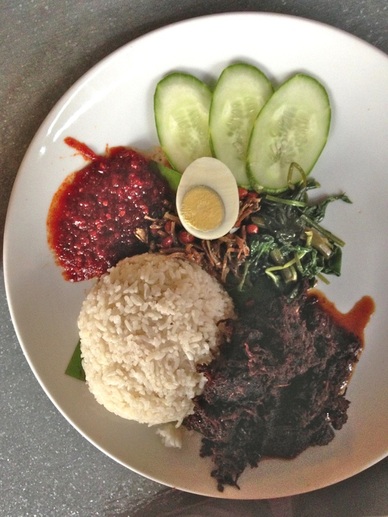Speaking of the latter, just last week, I had trouble recalling the name of the store even though I could still picture the sections and aisles clearly. Especially the pork store-within-a-store. This random bout of amnesia reinforces the good habit of snapping candid photos of one's mundane routine, because what is mundane today may become sweet reminiscence in future. Friends with kids would agree. Likewise friends who are nomads.
One late Saturday afternoon, I had my best meal at Chawan, perhaps because I starved myself earlier on knowing what I would order from their menu of Malaysian comfort foods. But what really got me in excited anticipation was that I was finally meeting two dear friends from secondary school - after twenty lost years. E and A were schoolmates a year my senior, with whom I would loiter around the open hall in the afternoon after lessons. Being Convent girls, we certainly were not the giggly sort. No. We were the cackle and guffaw type. The ones teachers would find a menace to classroom orderliness.
Listening to all our stories and updates, I dug in to Chawan's nasi lemak with beef rendang tok - the very plate you see at the top of this page. All my life growing up in Malaysia, it never occurred to me that rendang dishes vary depending on their state of origin. By that I mean the thirteen states in Malaysia (like the fifty that the USA has, for the benefit of friends unfamiliar with my home country). For me, back then, rendang is simply just that. The only differing factor was the choice of protein, beef or chicken being the most common in my family. All thanks to Chawan, this ignorant Malaysian has the name "rendang tok" registered in her must-learn-to-make list.
There are many recipes for this on the internet, my favorite being that by Norman Musa, a Malaysian chef based in London. There is another recipe by Marc Matsumoto whose blog is a treasure trove for global cuisine. Offline, I am a fan of Wendy Hutton's books on Southeast Asian cuisine. Ms Hutton had spent more years living in the region than I have been alive. Her recipes are reliable and generous with helpful tips, unlike most cooks back home who would share their recipes while withholding the crucial 10% for self-preservation. That's the typical Asian kungfu master tactic, not much different for paranoid cooks.
An informative introduction to the rendang dish can be found on Wikipedia. It is interesting how the dish came about: a self-preserving dish when cooked properly, Straits traders would bring it along on extended trips. For me to describe it, I would say rendang tok is a dry braise. Dry because even though the method is similar to braising - brown the meat, sauté the aromatics, deglaze (in this case with coconut milk), simmer - the rendang cuisson is left to evaporate to the point there is so little moisture remaining, the coconut fat begins to fry the rendang. The entire process takes easily four hours starting when the coconut milk is added.
Nonetheless, with regard to Ms Hutton's recipes, how ironic it is to learn from an "outsider" if one is unaware of her wealth of experience writing about food in the region, and even more ironic to learn to cook Malaysian in New York. My intention is to really learn to make it from scratch, just in case we live in some obscure countryside someday.
There are a few grocery stores in Manhattan's Chinatown that are pretty well stocked for Southeast Asian items. Commercially made spice mixes are widely available but chances are, you will need to adjust them further to your liking. Which implies having some spices and herbs in the kitchen. And that, in turn, leads some of us to "might as well make it ourselves".
If only for a day I could be invisible and teleport from one Malaysian kitchen to another, I would love to see the arsenal of spice pastes in the best makciks' and aunties' refrigerators, some of whose recipes have been passed down for generations.
Malaysian cuisine has such great wealth in history and heritage it must be preserved. We cannot assume that makcik will be waiting for you always with her nasi kerabu and serimuka. There is no better time to start your personal collection of favorite, fool-proof recipes for the benefit of your children and theirs.



